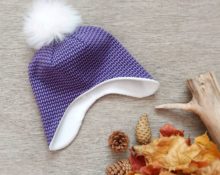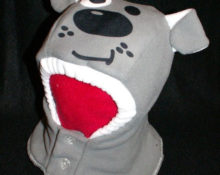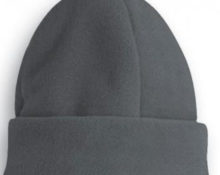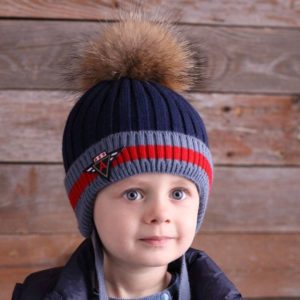 When buying a hat made of well-stretched knitwear, men and women have virtually no chance of making a mistake with the size. In this case, any errors are compensated by good stretchability. Such hats can be called universal.
When buying a hat made of well-stretched knitwear, men and women have virtually no chance of making a mistake with the size. In this case, any errors are compensated by good stretchability. Such hats can be called universal.
However, if the material is dense or not stretchy at all, then the choice becomes more complicated; you will need to find out the size.
Even more questions arise when buying children's hats, especially online. What is a hat size? This is the circumference of the head, expressed in centimeters.
Newborn hat size
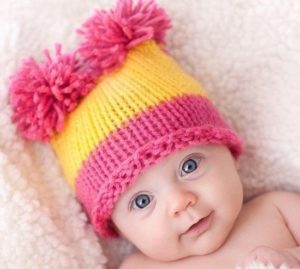
Trying on any product gives you confidence in the correct choice. However, this is not always possible, especially when it comes to buying hats for little ones online. You will have to either use the sizing chart or take measurements.
How parameters of newborns change
The value is influenced by the following developmental features.
- From 0 to 3 months, every month the girth increases by 2 cm.
- From 3 to 12 months - by 0.5-1 cm every month.
- From 1 year to 2 years – approximately 2.5 cm.
- From 2 to 10 years, each year it increases by only 0.5 cm.
As seen, the most intense change in size occurs in the first year of life. Then the pace slows down and the increase is not so rapid. This is due to the physiological characteristics of skeletal development.
It is important to choose the size carefully.
Important! The product should not be large, but squeezing the head should not be allowed.
Much depends on the quality of the product’s materials and cut. If the size of an ordinary hat is large, then it will not fit tightly, and it is easy for the child’s ears to get cold. You need to remember all this, because it’s much easier with adults. They can complain and talk about discomfort, but the youngest are deprived of this opportunity.
How to take measurements
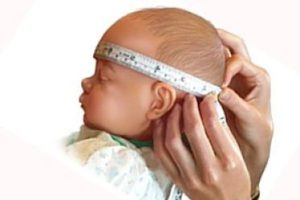
The main measurement is head circumference. The remaining measurements are additional and clarifying.
Measurements should be taken horizontally using a measuring tape.. You need to stretch it over the eyebrow line, ears and through the most protruding area of the back of the head.
Important! If you don’t have a tailor’s centimeter at home, you can measure the circumference of your head using a regular thick thread.
You don't need to pull it too tight, just apply it to your head in the usual way. Then simply measure the resulting segment using a regular ruler.
Size chart for babies
If the child develops in full accordance with generally accepted standards, then you don’t even need to take measurements. Just use the size chart by looking at the product data by month of the baby in the corresponding column. Many mothers do this and are not mistaken. However, it is often necessary to take measurements, for example, in cases where the child’s head is larger than that of other peers.
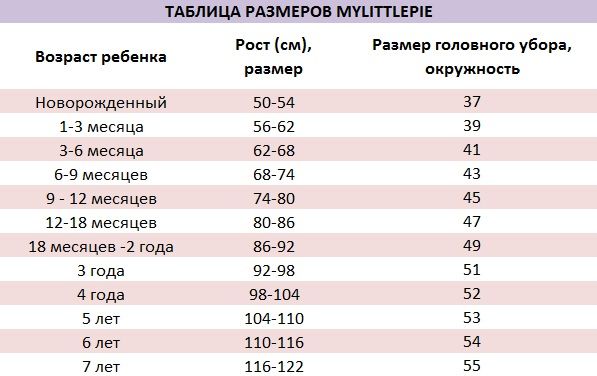
Important! The size chart is also convenient to use if you want to choose a hat as a gift for the child of a friend or relative.
In this case, it is enough to know how many months the baby is and find out what size corresponds to this age. But It’s better to buy with a small reserve for growth.
Children's hat size
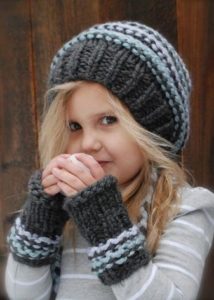
Often the manufacturer only indicates the age of the child on product tags. But children can develop differently, which is why some have parameters that differ from the standard ones.
To determine the size of a hat for a child, you need to take into account that when choosing a headdress for more than one season, the materials must be elastic.
The choice of product must be approached with the utmost seriousness. If it is chosen incorrectly and turns out to be small, it will “bounce”, revealing the entire forehead and partially the back of the head. Of course, such a product will cause discomfort and will not help much in cold weather.
Advice. For girls who have extra volume on their heads (braid, bun, ponytail), it is better to choose elongated models.
What measurements are needed
The size of the head circumference is determined using a tailor's centimeter. Additional measurements can be used for greater accuracy. This is the diameter of the bottom and the depth of the headdress.
- Diameter is the head circumference divided by 3.14 minus 2 cm.
- Depth is determined by measuring the distance from the crown to the edge.
Knowing all these parameters, your child can easily choose a hat, cap or baseball cap without additional fitting.
This data may also be needed when sewing a hat or a carnival children's costume, if it includes a headdress.
Size Chart for Boys and Girls
Comparing the obtained measurement results, you can see the required size in the table. In children's hats, the head circumference is equivalent to the size of the product.
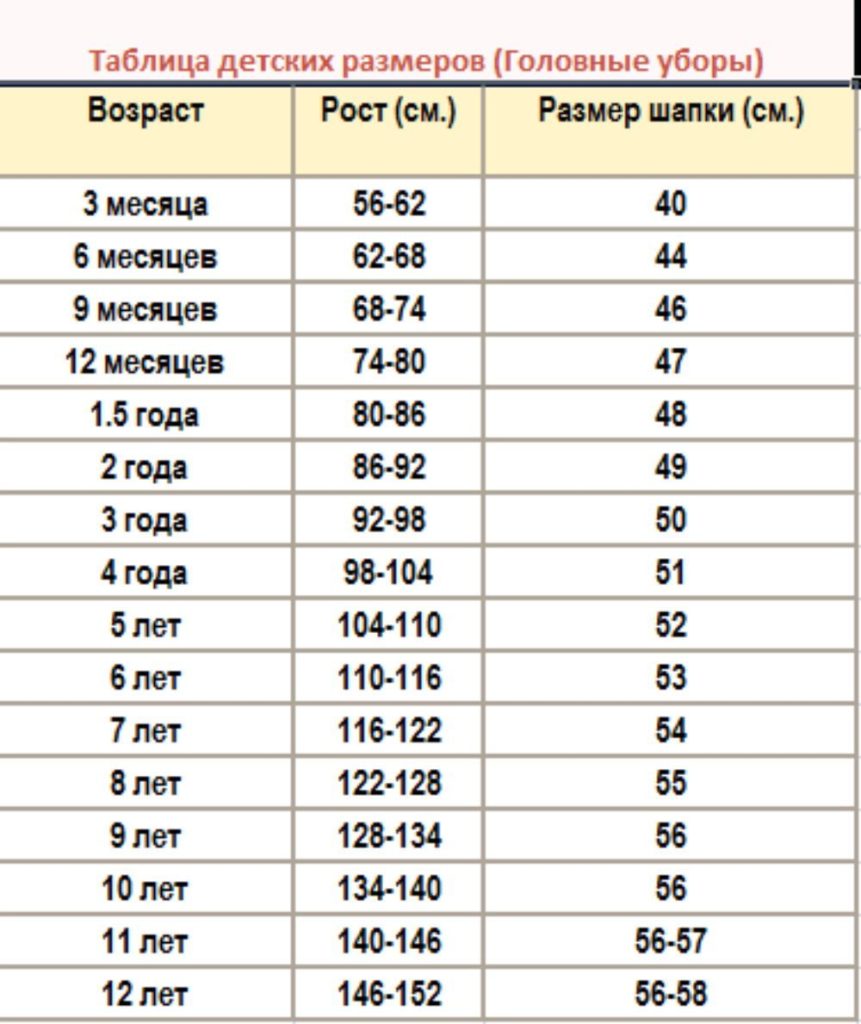
Ideally it should be a little larger. For example, with a volume of 47.5 cm, a size 48 product is suitable.
Important! Boys and girls have slightly different head circumferences, with an average difference of about 1 centimeter.
Adult hat sizes
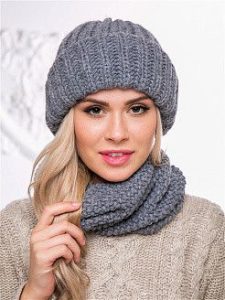
When choosing hats for adults, you should not forget about the existence of standard sizes.
- For women - gradation from 54 to 61.
- For men's - size range from 54 to 63.
These numbers indicate the size of the head circumference. As with children, measurements are taken with a tape passing over the eyebrows, ears and across the back of the head.
Knowing this value, all that remains is to compare it with standard measurements. For example, if the measurement result is 56 cm, then the standard size for the hat will be No. 56.
Important! When buying a fur hat, you need to make sure that it fits exactly to the size.
The product should not be worn by force. It should not be allowed to dangle from side to side or fall over the eyes.
International sizes

If we compare children's size charts with adults, then in the latter case there is no longer any need to indicate age. For ease of selection, the sizes themselves are usually indicated by symbols: S, M, L, XL, XXL, etc. Buyers are already accustomed to this scale, and they quickly understand which product they need to buy. There is no need to even compare with standard sizes.
According to generally accepted international standards, the following compliance with head circumference is provided.
- S - 53-54 cm.
- M - 55 cm.
- L - 56–57 cm.
- XL - 58 cm.
- XXL - 59–60 cm.
- XXXL - 61 cm.
What features of a hat affect its size?
Several features can further influence the size of the hat.
- Knitting pattern. With a voluminous pattern should subtract 1 cm from the girth raises.
- Product density. When choosing a loose and voluminous hat, depending on the girth size heads 2 cm is subtracted.
- Number of seams: one, two or even seamless. The fewer seams, the greater the stretchability of the product.
- Product material or yarn type. You can sew or knit a hat from a variety of materials: acrylic, wool, cotton or viscose. Cotton and wool will shrink during wear, while acrylic, on the contrary, will stretch.
Taking into account all the features of determining the size of hats for adults and children, you can select, sew or knit a headdress without errors.
If the hat is chosen correctly, then it is practically not felt and does not cause discomfort while wearing.


 1
1